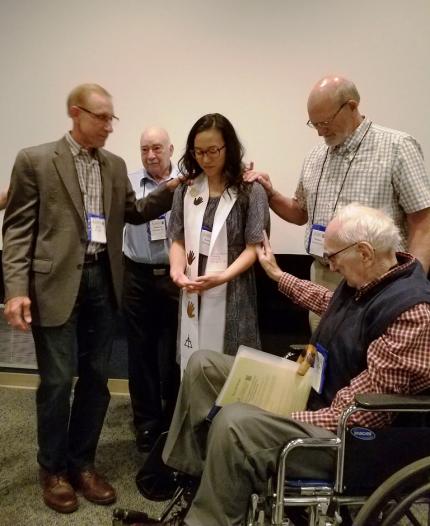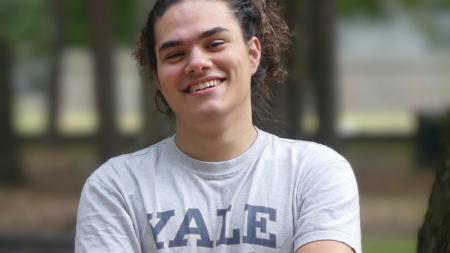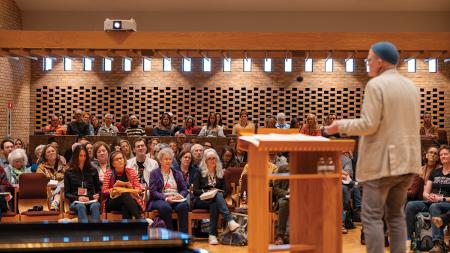Passing on the Stole of Leadership for Chaplaincy

Former chaplaincy office directors (from left) Ron Klimp, Herm Keizer, Seibert VanHouten and Hal Bode pray for Sarah Roelofs.
Chris Meehan
During last week’s Chaplaincy and Care conference, Rev. Ron Klimp handed a white stole, decorated with the hands of mercy, a shepherd’s staff, and a cross, to Rev. Sarah Hae Kung Roelofs, signifying the transition in leadership of the CRC’s Office of Chaplaincy and Care Ministry.
Until April, Klimp served as director of the office. Roelofs has now stepped into the position, marking, among other things, the first time a woman has led the office that endorses, offers ongoing education for, and stays connected with CRC chaplains serving in a variety of settings around the world.
“Herm Keizer [former director of the office] honored me with a stole seven years ago when I started as director,” said Klimp. “We are giving it to Sarah as a symbol” of her new role in leading the office, which celebrates its 75th anniversary this year.
More than 100 CRC chaplains and their spouses were on hand at the Calvin College Prince Center on Thursday, June 8, to witness the ceremony near the start of the annual conference, which brings chaplains from the military, health care settings, prisons, counseling centers, and other areas together to conduct business, listen to speakers, attend workshops, and discuss their ministries.
After receiving the stole, Roelofs addressed attendees: “I’m honored to be in this position. I promise to you that I will advocate for you and for the people we serve.”
In February, the CRC’s Board of Trustees voted unanimously to appoint Roelofs to the position. She has served in a variety of hospital chaplaincy roles and in the U.S. Air Force Reserve.
“I know I have a lot to learn,” she said. Given that the conference celebrated the 75th anniversary of CRC chaplaincy, she added, “They [chaplains over the years] fought for us all to be sitting here. They were in the trenches. . . . They were pioneers who paved the way.”
Later that afternoon, Rev. Scott Hoezee, who wrote about the history of CRC chaplains in the book Flourishing in the Land, sketched how the growth of the ministry reflects and in some ways led in the development of the CRC.
“Chaplaincy has been at the crossroads of a lot of ecclesiastical discussions and disagreements,” said Hoezee in prepared remarks.
The denomination’s first chaplains served during World War I, and there was controversy from the start. Church leaders were wary of allowing clergy to get involved in an endeavor that meant mixing the church with the beliefs and practices of the wider world.
In fact, Synod 1918 only approved “of pastors from the denomination serving as chaplains . . . primarily to make sure that any Christian Reformed boys conscripted for the war would have a chance to receive any real spiritual nurture from perhaps the only military chaplain whose orthodoxy one could be sure of — and that was, naturally, a CRC pastor!” said Hoezee, who is director of the Center for Excellence in Preaching at Calvin Theological Seminary,
Although the first chaplains served during that war, the church didn’t begin what eventually became the chaplaincy office until 1942, when the United States entered World War II. As it turned out, the war played a big role in opening the CRC to a new world and new ideas.
“World War II had a big shaping effect on the denomination as not only the couple dozen CRC chaplains came home from the war, but so did many thousands of members of the denomination,” said Hoezee.
“They came home, many of them, changed men. They’d seen the world and had their eyes opened to new things. . . . The CRC’s religious fortress began to crumble a bit.”
Over time, chaplaincy expanded into many areas, finding itself engaging with people in a multitude of places and bringing the message of Christ, not so narrowly focused as before, to a larger community.
And chaplains began doing this more often through the ministry of presence and compassion than through traditional evangelization.
In prisons, in the military, in hospitals, and in the workplace, chaplains today work with people of all faiths and no faith at all, exemplifying the love of Christ through their actions. Only after responding to a person’s immediate needs do chaplains, when asked, discuss their faith.
“Chaplains are on the front lines very often on what is sometimes described as the flying wedge of God’s missional people as it soars along in history and throughout the world.
“Chaplains have helped to open up the once-insular CRCNA to the wider world in which God is active and that he loved so much that he sent his only begotten Son to suffer and die for that world,” said Hoezee.
In following the way of Jesus, said Ron Klimp, chaplains “often touch people that other people may not have touched. . . . Jesus stepped outside the usual structures and procedures.”
Chaplains, he said, are often able to reach into parts of the world that the church cannot access in any other way.
After receiving the stole, Sarah Roelofs also said, “My vision is to see how we are connecting with God and loving one another, the church, the denomination, and the world.”
On Saturday, June 10, the chaplains met via a live Internet feed with delegates to Synod 2017 to offer greetings to and share some of their history. Read story.


